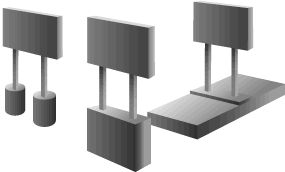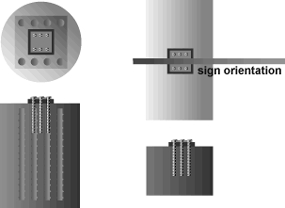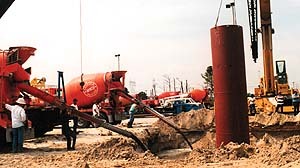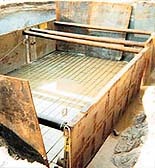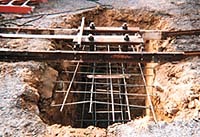Metal Fabrication
Concrete Ideas
Subterranean details ensure the safety of freestanding signs
Published
18 years agoon
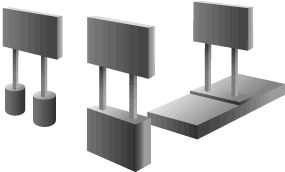
The most important part of a freestanding sign is the one that’s buried in the ground. Concrete footers unobtrusively anchor pole-mounted signs against the forces of nature, safeguarding the user’s investment, as well as human lives and property. Although the designs of most pole-sign footers are quite simple, it’s dangerous for novice installers to infer that this presents an opportunity for experiments or guesswork.
First and foremost, a sign footer must be properly engineered according to the size and height of the sign, and its proposed location. The footer’s physical dimensions and the size of anchor bolts (if used) are critical for a safe project. Hence, it behooves sign companies to use only engineered designs, and to ensure that all installations conform strictly to the project plans.
Can you dig it?
The nature of the soil in the sign’s proposed location affects the engineer’s design criteria and the footer type selected. Because sign erectors ordinarily can’t determine in advance whether subterranean rock layers will block their excavation work, engineering plans for large-scale sign programs commonly include alternative types of footers for various local conditions. Three basic footer designs are caisson, vertical slab and horizontal slab (Fig. 1).
In terms of concrete consumption, caisson footers are the most economical. The anchoring strength of this type derives primarily from its greater depth of penetration into the earth. As Fig. 2 illustrates, a sign that could be supported by a caisson footer comprising only 4.25 cubic yards of concrete would require a horizontal slab footer comprising 14.4 cubic yards. Using a typical price of $70 per yard for ready-mixed concrete delivered to a job site, the cost to pour a caisson footer for this sign is $298, compared with $1,008 for a horizontal slab.
Planners should carefully consider this significant cost difference when bidding a project in an area known for rocky soil. This might prevent drilling a caisson or excavating a vertical-slab footer, and it’s wise to include a contract addendum that covers the additional costs to switch to a horizontal slab design. This addendum should also include labor and equipment costs to jackhammer and remove rock from the excavation.
When you quote pole-sign projects, it’s important for customers to understand that your price is based on installing an economically designed footer in ordinary soil. To avoid any disputes, it’s a good idea to include a "rock clause" in your contract. Always contact local utility companies before you excavate to ensure you won’t encounter any underground pipes or electrical lines. Striking natural gas pipes or underground high-voltage cables can be deadly to your crew. If your backhoe snaps a public water line, the repair costs can be quite high.
Although caisson-type footers consume substantially less concrete than other types, the excavation must be drilled with an auger machine. If your sign company doesn’t own an auger, you may find it difficult and costly to hire this equipment (in some areas, augers may not be available at all). Also, unlike the backhoe/dump truck tandem, augers can’t do anything with the soil once it’s removed from the excavation. Unless your project is located on an unpaved site where the excavated soil can simply be spread out around the footer, your crew will have to remove it from the site. These problems explain why most sign companies excavate slab- or block-shaped footers using backhoe equipment.
Another common problem is groundwater in the excavation. This is very common in Florida and coastal areas where the water table is close to the surface, but it can also occur in any area where the ground has been saturated by recent heavy rainfall, or where underground springs or storm drains are nearby. Just because concrete in its plastic form is a water mixture, don’t assume you can simply pour it into a water-filled excavation. Excessive water seriously weakens the concrete, and sign companies should pump all ground water out of their excavations before pouring sign footers. If the footer is fairly large, you may need to hire a contractor who specializes in "dewatering" service. This can be expensive, and it’s something you must consider as an addendum to your price quote. On a recent high-rise sign project in Florida, Roman Sign (Ladylake, FL) struck water 3 feet below the ground surface. Company President John Roman hired a subcontractor to remove water while the excavation was completed, and to keep the hole dry until the concrete had been poured (Fig. 3). Because of the state’s sandy soil, the sides of excavations in Florida typically cave-in, enlarging the hole in the process. To avoid ordering more concrete than the hefty 350 cubic yards called for, Roman Sign rented a steel trench box, which was placed in the excavation to prevent cave-ins (Fig. 4). According to Roman, the costs for dewatering and renting the trench box were substantial. The concrete alone for this project cost $20,000.
True to Form Barring a cave-in situation like that described in Roman Sign’s project, embedded-column footers do not require extensive forming. Anchor-bolt footers, however, are more complex and need to be more carefully installed. Footers for double-pole signs must be installed with even greater precision, because maintaining the correct center-to-center dimension between the poles is critical for the sign installation. This is accomplished by constructing a wooden or steel form that serves as a template for placing the anchor bolts (Fig. 5). This form maintains the correct spacing between opposite sets of anchor bolts, retains the bolts while the concrete is poured, and creates finished footer caps that elevate the bolts’ exposed portions above the level of standing water (typically 4-6 inches). The form also holds the opposite bolt templates square in relation to each other.
Properly level your form after placing it over the excavation(s). If the form is not level from one template to the other, it might be difficult or impossible to level the two poles when the sign is erected. Also, when placing the anchor bolts in the form, the length of bolt thread protruding above the top nuts (rule of thumb: the pole’s base-plate thickness plus 1.5 inches) should be approximately equal on each side of the form.
Before pouring concrete, your form must be sturdy and well-braced. Wet concrete is quite heavy, so pour it carefully to avoid pushing the form out of position or skewing the anchor bolts. It’s good practice to connect the anchor bolts for each pole together by welding steel braces between them. Brace the bolts additionally by connecting them to the reinforcing-bar (rebar) mats inside the excavation (Fig. 6). Also, make sure that your electrical conduit is tied or braced in the proper position, with the open end capped to keep out dirt and concrete. The best materials for fabricating sturdy forms are steel angle and channel. Steel forms can be designed to bolt together for easy assembly and removal. Wooden forms may not be sturdy enough for large projects.
Like a rock
Although monolithic concrete has substantial strength in compression (against the downward force of the sign structure’s dead weight), it’s extremely weak when exposed to tension forces and freeze/thaw cycles. For this reason, it’s essential to reinforce sign footers with steel rebars arrayed in grid-like mats throughout the concrete mass. These rebars must have at least 3 inches of concrete cover to protect against deterioration. If the footer is not reinforced, it can fracture into smaller pieces over time, seriously weakening the sign structure.
Although various available chemical additives increase or decrease concrete’s workability and setting time, most are not recommended by structural engineers, because they weaken the finished product. Therefore, sign companies should rely on the specific mixture proportion of water, sand, gravel and cement — not additives — to produce the desired consistency for particular projects. Many concrete batch plants routinely add a calcium-chloride accelerator (at additional cost) for cold-weather projects, but some experts disagree with the practice.
Sign footers must be completely poured at one time. For very large footers like the one Roman Signs installed, you’ll need a hauler that can dispatch a fleet of mixers to your job site (most cement mixers can hold 6-10 yards of concrete). Regardless of the project’s size, it’s very important that the cement-truck operator move his delivery chute around to distribute the concrete equally as the excavation is filled (cement-truck drivers can be surly, so don’t be afraid to ask them to reposition their truck if necessary). If the concrete is simply poured into a single heap, cavities may develop that will seriously weaken the footer. Also, your crew should have long-handled shovels or steel digging bars on hand to agitate the concrete as it pours. This guides the concrete around the anchor bolts and rebars, filling-in the voids. Powered concrete vibrators are also available for this purpose.
Finally, it’s important to know when to stop pouring. You only want enough concrete to fill to the top of your form. To make the sides of the footer cap smooth, use a trowel around the edges and a hammer to tap around the outside perimeter of the form. Using concrete tools, neatly finish the top of the footer cap. When your finishing work is complete, cover the top of the footer with a plastic tarp to retain moisture. Water, not air or sunshine, is the primary catalyst that hardens concrete.
If properly installed, a footer will support its sign safely for many years. Conversely, the installer who cuts corners on footer specifications might discover a courtroom in his crystal ball. That’s why it’s important for the unseen components of sign structures to be as carefully executed as the components that appear on magazine covers.
SPONSORED VIDEO
Introducing the Sign Industry Podcast
The Sign Industry Podcast is a platform for every sign person out there — from the old-timers who bent neon and hand-lettered boats to those venturing into new technologies — we want to get their stories out for everyone to hear. Come join us and listen to stories, learn tricks or techniques, and get insights of what’s to come. We are the world’s second oldest profession. The folks who started the world’s oldest profession needed a sign.
You may like
Advertisement
Subscribe

Magazine
Get the most important news
and business ideas from Signsofthetimes Magazine.
Advertisement
Most Popular
-

 Tip Sheet4 days ago
Tip Sheet4 days agoAlways Brand Yourself and Wear Fewer Hats — Two of April’s Sign Tips
-

 Business Management2 weeks ago
Business Management2 weeks agoWhen Should Sign Companies Hire Salespeople or Fire Customers?
-

 Women in Signs2 weeks ago
Women in Signs2 weeks ago2024 Women in Signs Award Winners Excel in Diverse Roles
-

 Real Deal5 days ago
Real Deal5 days agoA Woman Sign Company Owner Confronts a Sexist Wholesaler
-

 Benchmarks22 hours ago
Benchmarks22 hours ago6 Sports Venue Signs Deserving a Standing Ovation
-

 Editor's Note1 week ago
Editor's Note1 week agoWhy We Still Need the Women in Signs Award
-

 Line Time2 weeks ago
Line Time2 weeks agoOne Less Thing to Do for Sign Customers
-

 Product Buying + Technology1 week ago
Product Buying + Technology1 week agoADA Signs and More Uses for Engraving Machines

